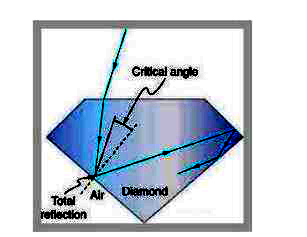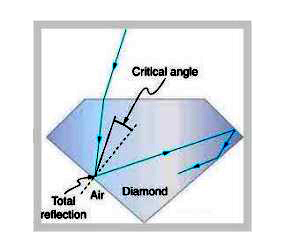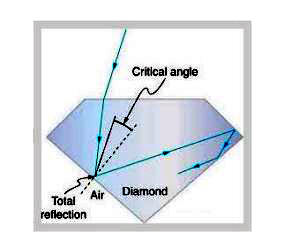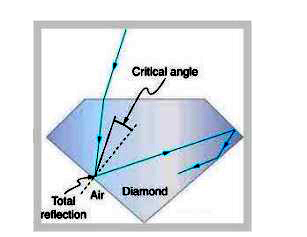Sparking Brilliance of Diamond:

The total internal reflection of the light is used in polishing diamonds to create a sparking brilliance. By polishing the diamond with specific cuts, it is adjusted the most of the light rays approaching the surface are incident with an angle of incidence more than critical angle. Hence, they suffer multiple reflections and ultimately come out of diamond from the top. This gives the diamond a sparking brilliance.
The basic reason for the extraordinary sparkle of suitably cut diamond is that
high refractive index
Topper's Solved these Questions
- SAMPLE QUESTION PAPER (THEORY)BOOK - CBSE MODEL PAPERCHAPTER - SAMPLE QUESTION PAPER (THEORY)EXERCISE - Section – C
12 Videos
- SAMPLE QUESTION PAPER (THEORY)BOOK - CBSE MODEL PAPERCHAPTER - SAMPLE QUESTION PAPER (THEORY)EXERCISE - Section -D
7 Videos
- SAMPLE QUESTION PAPER (THEORY)BOOK - CBSE MODEL PAPERCHAPTER - SAMPLE QUESTION PAPER (THEORY)EXERCISE - Section – E
6 Videos
- SAMPLE PAPER 2023 TERM IBOOK - CBSE MODEL PAPERCHAPTER - SAMPLE PAPER 2023 TERM IEXERCISE - SECTION D
4 Videos
Similar Questions
Sparking Brilliance of Diamond:

The total internal reflection of the light is used in polishing diamonds to create a sparking brilliance. By polishing the diamond with specific cuts, it is adjusted the most of the light rays approaching the surface are incident with an angle of incidence more than critical angle. Hence, they suffer multiple reflections and ultimately come out of diamond from the top. This gives the diamond a sparking brilliance.
The critical angle for a diamond is 24.4∘. Then its refractive index is
View SolutionSparking Brilliance of Diamond:

The total internal reflection of the light is used in polishing diamonds to create a sparking brilliance. By polishing the diamond with specific cuts, it is adjusted the most of the light rays approaching the surface are incident with an angle of incidence more than critical angle. Hence, they suffer multiple reflections and ultimately come out of diamond from the top. This gives the diamond a sparking brilliance.
Light cannot easily escape a diamond without multiple internal reflections. This is because:
View Solution
Knowledge Check
Brilliance of diamond is due to
Ashape.BcuttingCreflection.Dtotal internal reflection.Brilliance of diamond is due to
AShapeBCuttingCReflectionDTotal internal reflectionDuring total internal reflection, the energy of the incident light
Ais absorbed by the reflecting surface.Bis not absorbed by the reflecting surgace.Cincreases.DNone of the above
Sparking Brilliance of Diamond:

The total internal reflection of the light is used in polishing diamonds to create a sparking brilliance. By polishing the diamond with specific cuts, it is adjusted the most of the light rays approaching the surface are incident with an angle of incidence more than critical angle. Hence, they suffer multiple reflections and ultimately come out of diamond from the top. This gives the diamond a sparking brilliance.
A diamond is immersed in a liquid with a refractive index greater than water. Then the critical angle for total internal reflection will
View SolutionSparking Brilliance of Diamond:

The total internal reflection of the light is used in polishing diamonds to create a sparking brilliance. By polishing the diamond with specific cuts, it is adjusted the most of the light rays approaching the surface are incident with an angle of incidence more than critical angle. Hence, they suffer multiple reflections and ultimately come out of diamond from the top. This gives the diamond a sparking brilliance.
The following diagram shows same diamond cut in two different shapes.

The brilliance of diamond in the second diamond will be:
View SolutionDraw ray diagrams for incident rays at angle of incidence less than critical angle and more than critical angle?
View SolutionA ray of light travelling in water is incident on its surface open to air. The angle of incidence is θ, which is less than the critical angle. Then there will be
View SolutionTotal internal reflection of a ray of light is possible when the (ic= critical angle, i= angle of incidence)
View Solution
